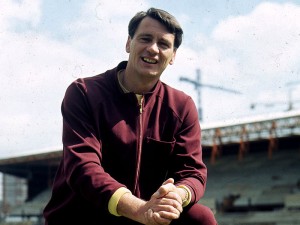There was a period in the early 1980s when the great clubs of England’s industrial cities gave way to smaller clubs from quieter places. Southampton, Ipswich, Norwich, Watford and Luton all had their great days between Clough’s first European Cup and the end of the Falklands Conflict. To this south-eastern boy, they were home teams, teams you could conceivably go to watch. They hadn’t the big names or the history. But perhaps they were the future. They were the Friendly Clubs.

Ipswich Town were always a homely sort of colossus, and they’ve left a comparatively cuddly monument in the lone and level sands. But for an eighteen month period at the start of the 1980s, they had a presence that only the Liverpool of Rush and Dalglish could match.
Practically every great post-Ramsey Ipswich player was on view that day against United. Surely that side, clearly the best in England, deserved better than just a European trophy and the semis and the second-places that they actually received.
They were a glamorous team only for their play. Suffolk lacked mines for Bobby Robson to whistle down. His Ipswich had medieval faces and tradesman’s names: Butcher, Cooper, Mariner, Mills. If you look at the team photograph now, it’s easy to imagine Robson following William Dowsing from church to church, Southwold, Walberswick, Blyford, Laxfield, and calling his men to him from the backs of pews and from high on the ancient stone.
Except for Eric Gates, whom Robson discovered in gnome costume, fishing for carp by someone’s pond in backstreet Bungay.
Perhaps not, but magic of some kind there must have been, because it all happened so quickly for Ipswich. They turned pro in 1936, became League Champions twenty seasons later, and within forty had added the FA Cup, the UEFA Cup, and scalps like Real Madrid’s and St Etienne’s. An even greater feat of chronology followed in 1981 when Messrs. Wark, Osman and co. inspired Escape to Victory.
It was the era of the friendly clubs – Ipswich, Norwich City, Luton Town, Watford and Southampton. Nevertheless Ipswich’s success defies easy analysis.
Bobby Robson inherited Mick Mills, but apart from Dutchmen Thyssen and Muhren, every other member of that 78-82 glory team was brought to Ipswich young, cheap and obscure. The blue streak was 1971-6, when Robson found John Wark, Russell Osman, Paul Cooper, George Burley, Eric Gates, Terry Butcher, Paul Mariner, Kevin Beattie, Allan Hunter and Roger Osbourne.
Missing from that list, because they came before or after, are Mick Lambert, Clive Woods, Trevor Whymark, Brian Talbot and Alan Brazil. Surely Bobby Robson’s Ipswich Town are the most remarkable example of team building to be found in English League history.There is nothing like it before, during or after the Maximum Wage.
Robson thought Trevor Beattie the best of them. Indeed, he thought him the best English-born player he’d ever seen, and that at the end of a management career which had involved Alan Shearer.
But it was the team’s reassuring, moustachiod uncle, Mick Mills, that my mates wanted to be. He was a man out of Macdonald Fraser, the eternal NCO who gave his life for Flashman or wasted his time over McAuslan time and again. Bloodyminded, sensible and hard as nails, he was the ideal foil for Robson, a balance for the manager’s inspiration and hysteria. Ron Greenwood, who knew Bobby Moore, made Mick Mills captain of England.
The England strip updated Mills and replaced his valve-work with silicon circuitry. When the dugout grieved and panicked, he, alongside his true contemporaries Brooking and Keegan, kept his nerve.
Yet Mills was betrayed, in the end. Robson left for the England job at the end of 1982, but first made sure he’d sold Mills out of the club he’d graced since 1966. Then he ended Mills’s England career along with Keegan’s and Brooking’s. Their replacements failed to qualify for the 1984 European Championship.
Perhaps it was just as well. Most of the great names were gone within two or three years, in a dismemberment greater even than that of Nottingham Forest. Brazil and Mariner went to London, Butcher to Scotland, the skipper to Southampton.
Those of us who’d loved and feared them in 1978-82 waited years for them to recover. Apart from one bright season under Robson protegee George Burley, they never came again. And that’s how you grow old.
But there’s one last turn to the story. Three decades on, most of that team, be they English, Scottish or whatever, have found their roots in Suffolk, and live there to this day.
A great team- perhaps what is interesting about that period 1970-90 is the rise and fall of hitherto obscure clubs- Ipswich, Forest, Leeds (if you go 1960-2005), Southampton, Luton, I’d add Coventry even- none of these are ‘traditional’ clubs but they all for a period graced the top flight.
Looking at the top league now- you’ve got strong representation from the North East (Newcastle, Sunderland, Middlesborough), from the North West (Bolton, Blackburn, Manchester clubs, Liverpool clubs, Wigan), from West Midlands (West Brom, Villa, Stoke, maybe Wolves next season) and from London (Arsenal, Tottenham, West Ham, Chelsea, Fulham) but only one Yorkshire club and one from the south outside London- Portsmouth. In a sense the traditional football regions have reasserted their dominance- you can’t really see Derby, Notts Forest, Leeds, Ipswich or Southampton coming back in force for a while!
A bit late, but what the heck; you mention Bobby Robson’s team building at Ipswich. And fair play. But how about the team that Bolton built for the 1958 FA Cup. It cost £110. Each player received a £10 signing on fee. At least that what my father told me. Several thousand times.
@Mikeovswinton: Not too late, and extremely interesting – I’ll follow that up. Thanks!